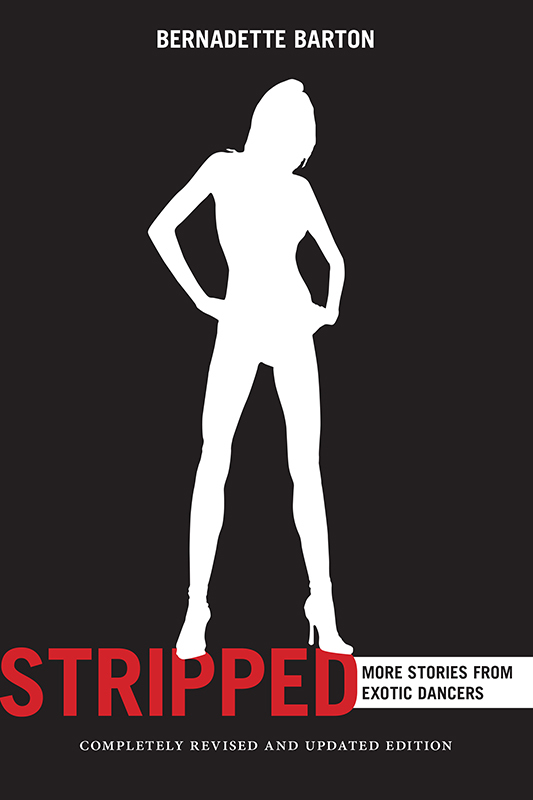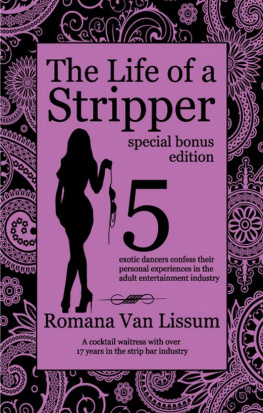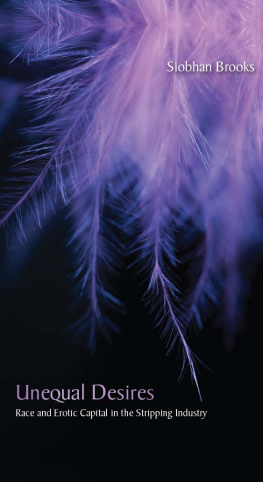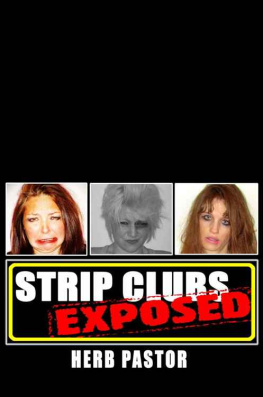
Stripped
Stripped
More Stories from Exotic Dancers
Completely Revised and Updated Edition
Bernadette Barton

NEW YORK UNIVERSITY PRESS
New York
NEW YORK UNIVERSITY PRESS
New York
www.nyupress.org
2017 by New York University
All rights reserved
References to Internet websites (URLs) were accurate at the time of writing. Neither the author nor New York University Press is responsible for URLs that may have expired or changed since the manuscript was prepared.
Library of Congress Cataloging-in-Publication Data
Names: Barton, Bernadette, author.
Title: Stripped : more stories from exotic dancers / Bernadette Barton.
Description: Second edition. | New York : New York University Press, [2017] | Includes bibliographical references and index.
Identifiers: LCCN 2016023918| ISBN 978-1-4798-9728-5 (cl : alk. paper) | ISBN 978-1-4798-1569-2 (pb : alk. paper)
Subjects: LCSH : Stripteasers. | StripteaseSocial aspects.
Classification: LCC PN1949.S7 B37 2017 | DDC 792.7dc23
LC record available at https://lccn.loc.gov/2016023918
New York University Press books are printed on acid-free paper, and their binding materials are chosen for strength and durability. We strive to use environmentally responsible suppliers and materials to the greatest extent possible in publishing our books.
Manufactured in the United States of America
10 9 8 7 6 5 4 3 2 1
Also available as an ebook
For all the feisty young women working to create a more just and joyous world
Contents
It is rewarding to appreciate and acknowledge all of the many individuals who supported this work and shaped this new edition of Stripped. First, this book would not exist without the dancers and other club employees willing to talk about their work and lives. Thank you all for your trust, openness, and honesty! Second, I thank a decade of curious, engaged, generous students taking my gender studies classes who fearlessly shared their insights about contemporary culture, and sometimes their personal experiences with the issues explored here. In particular, I recognize Hannah Mabry, whose excellent honors project inspired this new edition, and whose research assistance was invaluable throughout. Im certain you will go on to do great things, Hannah!
Many colleagues and friends supported the work published here. I appreciate Angela Aaron, Kathleen M. Blee, Tracy Blevins, Susan Bordo, Barbara Brents, Ric Caric, Charles H. Combs, Ashley Currier, Gail Dines, Anny Donewald, Patricia Estes, Katherine Frank, Ked Frank, Latonya Hesterberg, Breanne Fahs, Cynthia Ann Faulkner, Samuel Faulkner, Shelbi Hall, Constance L. Hardesty, Michael C. Henson, Crystal Jackson, Emily Jackson, Demi Jacques, Jeffrey A. Jones, Kody Kiser, Meg Lovejoy, Patricia Yancey Martin, M. Scott McBride, Shondrah Tarrezz Nash, Elizabeth Beall Perkins, Ellen Riggle, Sharon Scales Rostosky, Simon Ruchti, Lisa Huebner Ruchti, Chyng Sun, Brandon Perry Wengert, and Christopher Shawn Wright. Among my close friends, I offer a special thank you to Alexandra Teitz. Thank you, Alexandra, for years of asking important questions about my research, and enjoying our conversations about the answers.
This work also greatly benefitted from institutional support. Many thanks to the Office of Research and Sponsored Programs, the Caudill College of Arts, Humanities, and Social Sciences, the Gender Studies Program, and the Department of Sociology, Social Work, and Criminology at Morehead State University for providing research and travel funds, and release time, to complete this project.
I continue to feel enormously lucky to publish with NYU Press, and grateful to the hardworking, excellent, meticulous staff including Caelyn Cobb, Dan Geist, Dorothea Halliday, Mary Beth Jarrad, and Betsy Steve. Writing a new edition is a unique endeavor and I appreciate the opportunity NYU Press provided to revisit the material and explore some of the many changes that have taken place in the lives of exotic dancers. Special thanks to Ilene Kalish! Ive enjoyed over a decade-long relationship with Ilene, editor-extraordinaire, and deeply appreciate the distinctive combination of kindness, thoughtfulness, rigor, and framing that she brings to a manuscript.
Finally, I recognize my wife, Anna Blanton, who continues to support my provocative and controversial projects even when they drive her crazy. Much love to you, Anna.
Walking into Red Key, a strip bar in Silverton that serves an eighteen-and-older crowd, on a cold January afternoon in 2014, I greeted a bouncer at the front desk, Hi, Im Bernadette. I think weve met before. This was my third visit to Red Key to interview dancers, and the bouncer looked vaguely familiar. As a puzzled expression flitted over his features, he smiled politely and reached out to shake my hand. Yes, he responded, youre one of the church ladies, right? I smiled and said firmly, No, Im a researcher, and felt a mixture of relief and amusement that I was now of an age not to be mistaken for a dancer. Dressed in jeans and a thick sweater, I further appreciated this potential evidence that I had finally stopped fussing over what to wear when I go to strip bars. Since publishing the original edition of Stripped in 2006, I had gone on to research other topics, particularly the experience of being gay in the Bible Belt, but I had always remained interested in the lives of exotic dancers, a group of women who I believe are paradoxically maligned, grossly stereotyped, and overrepresented as one-dimensional sex objects.
Drawing on sixty interviews, including over two dozen new interviews with dancers and other club employees, over 150 informal conversations with dancers, and 150 hours of observation, this new edition of Stripped explores and documents how seismic cultural shiftsa lingering economic recession (2008), the rise of raunch (early 2000s) and hookup (mid- to late 2000s) cultures, and the dawn of the cell phone (2007)have changed the world of exotic dance. Reentering strip bars for this book, twelve years after I last regularly crossed such thresholds, I found that much had changed, perhaps the least of which was that I had a slightly easier time deciding how to present my physical self as a
The first time I went into a strip bar it was 1987 and I was nineteen, on spring break from college, visiting my friend Charles in Minneapolis. We were downtown looking for lunch and passed a storefront advertising dancing and a buffet. In the bubble of youth, and a former ballet dancer, I said to Charles, Oh, dancing, wouldnt that be fun! He looked puzzled, and said, Its not that kind of dancing, Bernadette. And then I realized the business was a striptease bar, not a disco, nor an Arthur Murray studio soliciting new students with a free lunch buffet. Later, after Charles had returned to work, I decided to check the club out on my own. When pondering what motivated me to enter a strip bar at all in my adolescence, I perceive that, like many young women Ive interviewed for this project, I was curious and I was broke. Also, I was confused by contradictory cultural messages telling me simultaneously that my most valuable asset was my beauty and body while cautioning me to protect my virtue. Finally, as a trained dancer in ballet, pointe, modern, and jazz, I felt more than a little aggravated that nine years of expensive dance lessons did not add up to much in the way of marketable skills.
Next page







